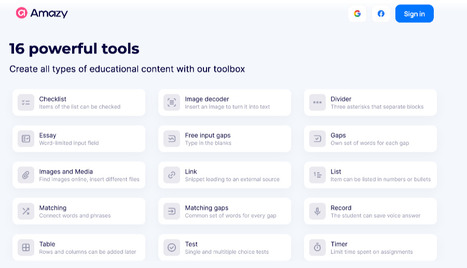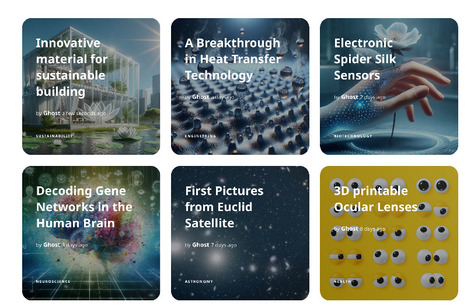Get Started for FREE
Sign up with Facebook Sign up with X
I don't have a Facebook or a X account

| Tags |
|---|
 Your new post is loading... Your new post is loading...
 Your new post is loading... Your new post is loading...
From
www
Using different AI tools at different stages of the lesson planning process can help teachers make effective use of their time. Via Nik Peachey 
Nik Peachey's curator insight,
Today, 1:56 AM
A useful article from Edutopia https://www.edutopia.org/article/ai-tools-lesson-planning
From
daily
A bibliography to help educators prepare students and themselves for a future shaped by AI—with all its opportunities and drawbacks. Via Nik Peachey, juandoming note préalable : cette enquête constituée de portraits est déclarative. Dans cet exercice de synthèse, nous avons retenu les éléments permettant de faire ressortir les grandes tendances. la rédaction Contexte : Une récente enquête du CREDOC estime que 31,5% des 18 ans et plus résidant en France... Via Bibliothèques-Médiathèques de Metz
Covid accelerated the digital revolution in education – now it’s time to harness what we’ve learned to make university work better for everyone, says Catherine Friday, global education leader at EY Via EDTECH@UTRGV 
EDTECH@UTRGV's curator insight,
May 31, 10:57 AM
"Students increasingly want to study at a time that suits them, due to work or family commitments"
ChatGPT Edu, emerging after initial partnerships with several universities, is prompting both cautious optimism and worries. OpenAI unveiled a new version of ChatGPT focused on universities on Thursday, building on work with a handful of higher education institutions that partnered with the tech giant. Via EDTECH@UTRGV 
EDTECH@UTRGV's curator insight,
May 31, 10:58 AM
"ChatGPT Edu, emerging after initial partnerships with several universities, is prompting both cautious optimism and worries."
From
wonkhe
How many people should go to university? Paul Wiltshire argues that we need a proper debate about student numbers Via Vladimir Kukharenko, juandoming
Blog de la "RIED. Revista Iberoamericana de Educación a Distancia". La Revista Iberoamericana de la Educación Digital. Via LGA
From
www
At the Reagan Institute Summit on Education, leaders discussed the evolving value of college degrees versus career skills. Via EDTECH@UTRGV 
EDTECH@UTRGV's curator insight,
May 29, 8:48 AM
"The line between work and education is increasingly blurred, according to education leaders, government officials, and other key stakeholders."
From
opencontent
Large language models (LLMs) make it possible for faculty to rapidly create a wide range of formative and summative assessments for their students. And, as we hear about so often, students can also use LLMs to write their essays and complete other assignments. Via EDTECH@UTRGV, juandoming 
EDTECH@UTRGV's curator insight,
May 29, 8:45 AM
"[W]hen faculty use AI to create assignments, it’s a 'productivity gain.' But when students use AI to complete assignments, it’s 'cheating.'”
From
amazy
Amazy is a fantastic tool for creating interactive worksheets for students. It's a bit like an interactive version of Twee and also has an LMS for tracking students answers https://buff.ly/4dTtg5T There's even a community that shares lesson materials. It can create lots of different types of activities, including ones that enable student to record and submit their speaking for evaluation. Via Nik Peachey
Using AI in L&D enhances personalized learning and efficiency but poses challenges like high costs and ethical concerns. Via Yashy Tohsaku, juandoming
Juan Domingo Farnós El análisis del aprendizaje implica la recopilación y el análisis de una amplia variedad de datos educativos, que pueden incluir datos de participación en clases, calificaciones, retroalimentación del profesor, resultados de exámenes, interacciones en línea, registros de actividades y otros tipos de datos relevantes. Estos datos se utilizan para identificar patrones, tendencias… Via juandoming
Learn how different generations prefer to learn and discover how this information can improve your training programs. Understand the learning preferences of Baby Boomers, Generation X, Millennials, and Gen Z. Find out what methods work best for each generation and how to tailor your training to meet their needs. Via EDTECH@UTRGV 
EDTECH@UTRGV's curator insight,
May 27, 11:51 AM
"In today’s workforce, as many as 60+ years or 3+ generations may separate the youngest employee from the oldest in any given company. Each new generation experiences unique changes to societal norms, historical events, and technological advancements." |
From
happydaze
Welcome to Happy Daze! Our website brings you scientifically-backed, positive news stories, each connected to an academic journal for in-depth understanding. Explore a world where every article is rooted in credible science, offering you not just uplifting content but also educational insights. Via Nik Peachey 
Nik Peachey's curator insight,
Today, 2:05 AM
A useful site for finding good news stories to share with students.
"Generative AI can be scary to some, so use these tips to help employees understand and adopt it." Via EDTECH@UTRGV 
EDTECH@UTRGV's curator insight,
May 30, 1:15 PM
"According to the World Economic Forum, 23% of positions will be added or eliminated as a result of technology changes, including AI adoption, in the coming five years."
Les IA destinées aux élèves visent principalement à personnaliser des cours déjà structurés. Tiennent-elles leur promesse de s'adapter au rythme de chacun ? Qu'en sait d'ores et déjà la recherche ?
Via Sandrine Decamps, Elena Pérez
The Trustnet browser extension lets individuals assess the accuracy of any content and fight online misinformation on any website. Via EDTECH@UTRGV 
EDTECH@UTRGV's curator insight,
May 31, 11:00 AM
"As many colleges implement digital literacy requirements for graduation, a browser extension helps combat online misinformation"
ChatGPT Edu, powered by GPT-4o, is designed for universities to responsibly integrate AI into academic and campus operations. This advanced AI tool supports text and vision reasoning, data analysis, and offers enterprise-level security. Via Edumorfosis, juandoming
Juan Domingo Farnós Para establecer un escenario educativo que se integre plenamente en la Educación 5.0 de Juan Domingo Farnós y que incorpore elementos de educación disruptiva y la inteligencia artificial (IA), es crucial diseñar un entorno innovador basado en la metacognición, la neurociencia, y las sinergias y sinapsis tanto algorítmicas como neuronales. Las sinergias… Via juandoming
From
outilstice
La même tâche compliquée revient tous les ans à peu près à la même époque. Il faut réfléchir et élaborer une structure d'école et créer des classes Via Fidel NAVAMUEL
From
edscoop
Boston University is among the latest higher education institutions to recommend its faculty not outright prohibit generative artificial intelligence tools. Via EDTECH@UTRGV, juandoming 
EDTECH@UTRGV's curator insight,
May 29, 8:53 AM
"In addition to pushing for generative AI’s embrace, Boston University’s task force also made several other recommendations, including that instructors should be free to define policies that are 'suited to the learning goals of their courses.' It says the university should also require that every instructor include an AI policy on each course syllabus."
Juan Domingo Farnós La modelización de visión-lenguaje (vision-language modeling, VLM) se refiere a la intersección de la visión por computadora y el procesamiento del lenguaje natural (NLP), donde se crean modelos capaces de entender y generar tanto texto como imágenes. Aplicar esta tecnología a la educación disruptiva y la inteligencia artificial (IA) puede abrir nuevas… Via juandoming
From
www
Les IA génératives, exportés dans le monde entier vont-elles engendrer une uniformisation des valeurs culturelles ? C’est ce que révélé une étude de 2022. Qu’en est-il aujourd’hui ? Via Bruno Renkin
From
leonfurze
However, as I’ve explored in previous posts on the capabilities and limitations of GenAI, I firmly believe that this technology is fundamentally unsuited for high-stakes student assessment. At its core, GenAI generates probabilistic outputs based on patterns in training data, lacking true understanding and the ability to make qualitative judgments. This leads to inconsistency and bias in grading, raising serious concerns about fairness and reliability. Via Edumorfosis, juandoming
Por Antonio Delgado En la primera parte presentamos el concepto de la Sinapsis Algorírmica . En esta segunda parte, nos dedicamos a descri... Via LGA |

































The how and why of it all....